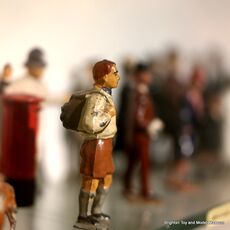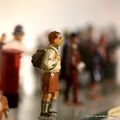Category:Joy of Little People (display)
| Display Area |
|---|
 |
| 07 - Joy of Little People (display) Arch Two |
| –– 01 02 03 04 05 06 07 08 09
10 11 12 13 14 15 16 17 18 19 20 21 22 23 24 25 26 27 28 –– 30 31 32 33 34 35 36 37 38 39 40 41 42 43 44 45 46 47 48 49 50 51 52 53 54 55 –– 57 58 –– –– 61 62 63 64 65 66 67 –– –– –– 71 72 73 74 –– 76 77 78 79 80 81 82 83 84 85 86 –– –– –– |
Collections of small painted human figures, mostly from the 1930s or earlier, and mostly originating in Britain or Germany. Most of these are made of cast and painted lead, but a few are made of "composition", a mixture of sawdust and glue.
History
Before World War One, Germany dominated the world market for metal toys, and the British market's strong tradition of international trading made it easy for these to be sold in the UK, leaving British manufacturers with no real incentive to try to compete. Up until the war, British-made toys had still tended to be made from hand-carved wood.
The main pre-war exception (along with Frank Hornby's "Meccano") was cast lead figures. The production of lead-cast figures required conventional carving techniques to make the moulds, but after this, melting and casting the lead could be done in a fairly small workshop with no machine tools, and painting the figures was again a matter of conventional pre-industrial craftmanship, and could be outsourced to other local workshops or craftsmen as piecework. Solid casting from finished moulds didn't require the same degree of technical knowhow as, say, printing lithographed tinpate or casting or machining stronger metals.
While the classic form of lead figure was the lead soldier (and German and British manufacturers did churn these out in huge quantities) toy soldiers were considered much less desirable after the horrors of the First World War, and the "figure foundries" looked for new designs that were less militaristic, producing cast lead model farms and zoos and garden sets, and supplying model passengers to populate the new gauge 0 model railway layouts.
Casting very "British" figures also gave smaller local UK manufacturers an edge over imported goods, whose German sculptors wouldn't be as likely to know what normal everyday traditional British people wore or behaved, and this gave British artists the opportunity to differentiate their work with a sometimes quite exquisite attention to detail regarding how they captured clothing, posture, movement, and mood. Some production from this period is notable for the subtlety of the poses with figures often caught in mid-movement, perhaps shifting their weight from one foot to the other, or straining to see something in the distance, or pausing in mid-stride, and when grouped together, these figures can provide a sometimes startlingly compelling three-dimensional colour view of day-to-day life in 1930s Britain.
Hollowcasting
The UK maker, William Britain advanced casting technology by inventing the hollowcast process in 1893, proving that the UK lead figure industry wasn't just copying the Germans, and hollowcasting helped "Britains" to expand and become the dominant UK brand.
The process involved using less metal and rotating the mould during setting to ensure that all parts of the mould surface were covered, and created figures that looked like solid lead, but were hollow. This didn't just mean that the figures used less metal, it also meant that the figures cooled faster than solid lead, reducing the waiting time between casting batches of figures from a single mould.
After World War Two
Of the UK manufacturers, it was only really "Britains" that survived the Second World War in a significant way – although the UK manufacturers generally managed to put their businesses into hibernation during the war years, once the hostilities ended they found that there were still difficulties sourcing supplies of lead, and although some managed to continue by using plastic or aluminium with the same moulds, others essentially gave up and sold their moulds to competitors. Britains persisted, but also eventually migrated their production to plastic.
Pages in category ‘Joy of Little People (display)’
The following 16 pages are in this category, out of 16 total.
Media in category ‘Joy of Little People (display)’
The following 3 files are in this category, out of 3 total.
- Area 07.jpg 800 × 799; 292 KB
- Lyons Nippy waitress (Pixyland-Kew).jpg 768 × 1,024; 357 KB
- TTR Passengers, Station Staff and Equipment (Trix Twin Railway).jpg 1,024 × 765; 431 KB






